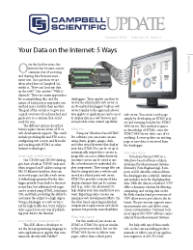Campbell Scientific provides measurement and control systems across a wide variety of disciplines, including both research and dayto- day applications. Flood warning projects are similar to many other applications we support in that they require continuous remote monitoring, low power consumption, system reliability in adverse conditions, accurate measurements, and telemetry to communicate data to a base station. Because of the life-impacting nature of the data from flood-warning systems, real-time communication capabilities are especially important. We offer three different types of systems for flood-warning applications.
Alert Stations
In the 1970s, the National Weather Service developed a protocol for flood-warning applications called ALERT (Automated Local Evaluation in Real Time). A standard ALERT system measures rainfall and water level and transmits data via a specific protocol to a base station. The system usually consists of sensors, datalogger, transmitter, and mounting standpipe. Our dataloggers easily meet the requirements for these systems, with specialized ALERT operating systems and excellent sensor compatibility. The programmable nature of our dataloggers means that stations can easily be upgraded without replacing hardware—something that will come in handy when the new ALERT-2 protocol is released. We can also upgrade older stations, even those from other manufacturers, with the latest datalogger and transmitter, allowing reuse of sensors, standpipes, or enclosures.
Hybrid Alert Stations
Often the capabilities of a standard ALERT station aren’t enough. Our hybrid stations remedy this by integrating additional sensors and two-way communication peripherals.
These additional capabilities can lead to collaboration between organizations, which can help keep costs down. Additional measurements that could be of interest include water quality, soil water content, or meteorological parameters.
Two-way communication provides the following advantages for remote monitoring applications:
- Retries of missed packets
- Diagnostics
- Clock synching
- Reprogramming from the base station
- Historical data collection (no holes in the data)
- Interactive control capability
- Voice modem call-out of alarms
Custom Flood-Warning Stations
Custom flood-warning systems take advantage of two-way RF communications and our network management software, LoggerNet. A LoggerNet-based system allows multiple sites to be polled each second. As the data is collected, LoggerNet clients can access it from LANs or via the Internet, making data available to multiple users/agencies. Smart, remotely-configurable repeaters can provide an adaptable network for stations in the same general area. The main third-party ALERT software, DIADvisor, has a client that links DIADvisor to the LoggerNet server, allowing data from a custom floodwarning network to mesh with a traditional ALERT warning system.
Over the years, our products have been used for all three types of flood-warning systems. With the many options available to us, we have the flexibility to create systems that meet each project’s needs. We’ll soon be releasing a new integrated ALERT enclosure that will simplify system configuration even more. Watch for it at campbellsci.com/flood-warning.
Measurements
Typical
- Rainfall
- Water level
- Flow rate
Optional
- Temperature
- Wind speed
- pH / ORP
- Wind direction
- Conductivity
- Relative humidity
- Turbidity
- Solar radiation
- Disolved oxygen
- Soil water content
Control
- Alarms
- Phone callouts
- Road signs
- Emails

